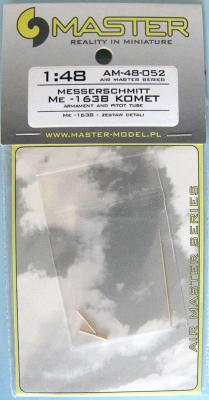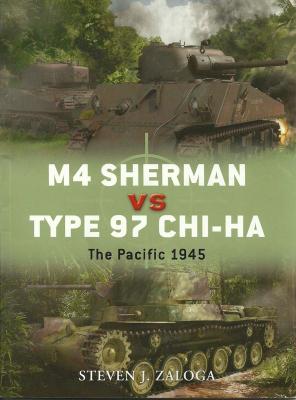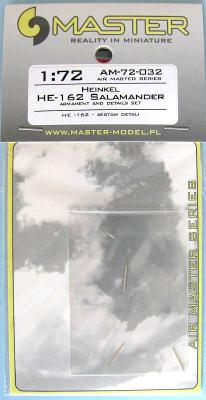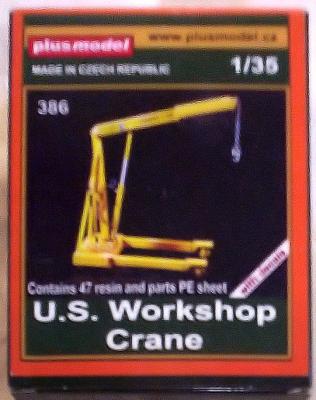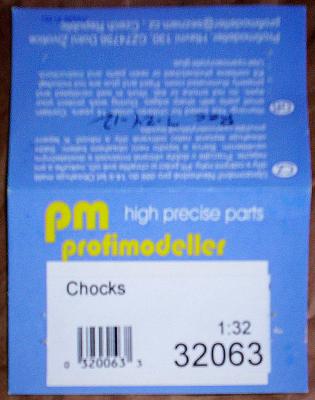As a member of the IPMS/USA Review Corps, I have had the wonderful opportunity to review a few items now from the Polish company Master Model. The topic for this review is a new set designed to upgrade your 1/48 scale Komet. Unlike most of the sets that I have reviewed, there is no recommended kit to use these new parts on, so I chose a Dragon release that was sitting in my stash. As with any of the other releases that I have come in contact with, these parts will greatly improve the look of your Komet.
Welcome to the IPMS/USA Reviews site!
Introduction: The primary organization of the IPMS/USA Review website is by IPMS/USA National Contest Class. Within each Class there are sub-menus by kits, decals, books, etc. The Miscellaneous Class is for items that are not class specific or that cross two or more classes.
IPMS/USA Members: We encourage you to submit reviews, both here and to the Journal. To volunteer for membership in the IPMS/USA "Reviewers Corps" and submit your own reviews, please read the Guidelines For Submitting Product Reviews.
Manufacturers, publishers, and other industry members: IPMS/USA is pleased to offer your company the opportunity for product reviews. All product reviews are performed by IPMS/USA members, and are posted in the publicly-accessible section of our website. With very few exceptions, we perform full build reviews of new kit releases, aftermarket products, and supplies. If you would care to provide product samples for review, please contact John Noack, IPMS/USA 1st VP.
To learn more about IPMS/USA, please see our About Us page.
This latest release in the Duel series by Osprey examines the conflict between the American M4A3 and Japan’s best tank of WWII, the Type 97-kai Shinhoto Chi-ha. As is typical for this series, this book provides detailed descriptions of the tanks and the men who operated and fought in them.
Not a lot has been written on tank battles in the Pacific theater. The region’s diverse terrain required a change in tactics, to where tanks were used as infantry support weapons as opposed to the maneuver warfare that usually led to major tank-vs.-tank battles. This book starts with the early encounters between the Japanese and the US in the Philippines in 1941, where US M3 Stuarts fought Japanese Type 95 light tanks. By 1944, both sides were deploying large numbers of tanks in combat. The Japanese committed an entire tank division to Luzon while the US Army had nearly a third of its armored battalions committed to the Pacific.
This is the seventh item that I have reviewed from Master Model, a Polish company that specializes in brass detail parts, typically in the form of gun barrels, antennas, and pitot tubes. This new 72nd scale release is designed for the Heinkel He-162 Salamander, and replaces the kit supplied forward pitot tube and gun barrels, and also provides a nose gear position indicator. No kit is mentioned for installing these parts onto, but for comparison purposes, I have put a Dragon release to use. As with the other releases from Master Model, these parts will dramatically improve the appearance of your plane, plus provide the nose gear indicator that I have not seen on kits in this scale.
History: The workshop crane was used in most machine shops or automotive shops, both military and commercial. It primarily was used to handle items up to 1,000 pounds in load.
Items in the box: The model is made from cast resin parts – grey in color. One fold-out instruction page, well presented. A metal chain for the hook is provided, as well as a small decal sheet.
Construction: Assembly started with the base, then the trunk, lifting arms, braces, and last, the lifting piston. Some small modifications were made to the crane. I substituted the pins with straight pins, cut to size. The wheels were made with thinner sheet plastic, as the original wheels were too thick for the yokes. I also used railroad bolts for the dolly. As illustrated, the box or load, an extra feature, mostly for effect. (Not supplied in the kit).
History
Chocks act as a safety device when placed under the wheels of a parked aircraft. This prevents the aircraft from rolling, especially when unattended or during an engine run-up.
Items in the Box
The units were resin cast material – white in color. One-page plans, good format.
Construction
The assembly is very basic. The cord or rope supplied looked large to me, so I used a thinner cord. (Thread: standard brown).
Finish and Detail
Used Floquil reefer yellow. I used black striping on one set of chocks. On the remaining two sets of chocks, I used the decals supplied on the instruction sheet.
Conclusion
With a slight modification, the units went together well. These units can be assembled by any inexperienced modeler. I wish to thank Profimodeller and IPMS for allowing me to review this kit.











